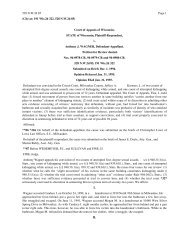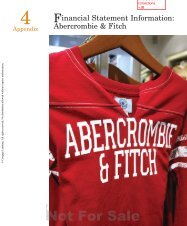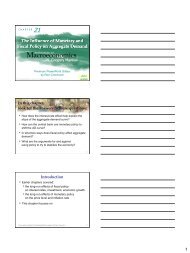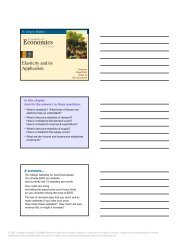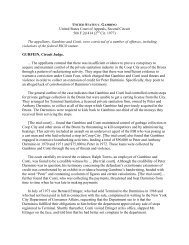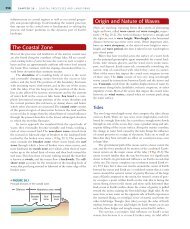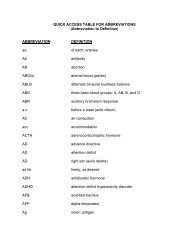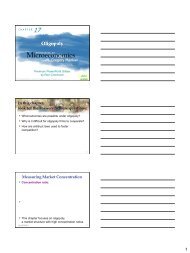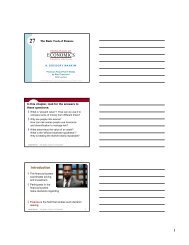Continuing Case - Cengage Learning
Continuing Case - Cengage Learning
Continuing Case - Cengage Learning
Create successful ePaper yourself
Turn your PDF publications into a flip-book with our unique Google optimized e-Paper software.
<strong>Continuing</strong> <strong>Case</strong><br />
New Improved Walmart<br />
Hits No. 1 in Midst of<br />
Global Recession<br />
Appendix B<br />
sell merchandise at rock-bottom prices and still make a<br />
profit. Walmart supercenters are the visual embodiment<br />
of such economies of scale: Spanning the length of multiple<br />
football fields, the massive one-stop marketplaces<br />
offer mountains of discounted brand name and private<br />
label merchandise across a range of categories, from gro-<br />
We live in turbulent times. Since the collapse of the U.S. ceries and electronics to housewares and automotive.<br />
housing market in 2008, the unemployment rate has Walmart’s success traces back to a legendary<br />
more than doubled. Iconic American businesses have American businessman, Sam Walton. Born in 1918 to<br />
gone belly up or been bailed out with taxpayer money. a farm family in Kingfisher, Oklahoma, Walton recog-<br />
Entire nations have teetered on the edge of bankruptcy. nized early in life that his ability to milk cows, deliver<br />
Yet, despite widespread turmoil, some organizations papers, and quarterback a team to a state football cham-<br />
have actually defied the global recession—Walmart is a pionship could lead to greater achievements. At college,<br />
case in point.<br />
Walton was head of the Reserve Officers’ Training Corps<br />
During this same period of economic decline, (ROTC), the founder of a newspaper delivery business,<br />
Walmart increased profits, created thousands of new and class president. After finishing studies at the Univer-<br />
jobs annually, expanded its operations overseas, launched sity of Missouri, with a degree in economics, the young<br />
a sustainable-business revolution, extended health cov- graduate went to work for J.C. Penney Co., where he<br />
erage to 1.2 million people, unveiled a hunger-relief learned retail sales and a technique called “management<br />
program, developed 75 percent of store management by walking around.”<br />
from hourly associates, and saved the average American After serving his country as a World War II Army<br />
household $3,100 annually. In the words of the company captain, Walton began to realize his full entrepreneur-<br />
motto, Walmart has helped people “Save money. Live ial potential. Upon leaving the service in 1945, Walton<br />
better.”<br />
became a franchisee of Ben Franklin Stores, where he<br />
As the world’s largest corporation and private em- honed his trademark strategy of purchasing in high volployer,<br />
Walmart possesses a massive economic profile. In ume while lowering markups. In 1950, he launched his<br />
2010, the Bentonville, Arkansas–based retailer hit No. 1 own store—Walton’s Five and Dime—in Bentonville,<br />
on the Fortune 500 list and was ranked among the top Arkansas. The rest is history: Walton opened the first<br />
ten world’s most admired companies. Fiscal year sales Walmart Discount City store in Rogers, Arkansas, in<br />
reached $405 billion, and the company’s diverse work- 1962, and in 1969 the business incorporated as Wal-Mart<br />
force grew to more than 2 million people worldwide. The Stores, Inc. After growing his company regionally for<br />
big-box leader operated 8,400 retail units in 15 countries, two decades, the affable “Mr. Sam” transitioned to chair-<br />
including 2,747 supercenters, 803 discount stores, and man of the board and set management’s sights on na-<br />
596 Sam’s Clubs in the United States alone. It donated tional and international expansion. Walmart opened its<br />
more than $400 million to charities and maintained part- first supercenter in 1988, moved into all 50 states by 1995,<br />
nerships with 61,000 suppliers. If Walmart were a coun- spread to 15 countries by 2005, and planned a global 50th<br />
try, its economy would rank among the top 25 nations, anniversary for 2012.<br />
rivaling Saudi Arabia and Sweden.<br />
Samuel Moore Walton passed away in 1992, but his<br />
The company’s recession-defying growth springs from spirit lives on in the company. From the first moment<br />
a familiar but groundbreaking retail formula: unbeat- Walmart opened as a single store in Rogers, Arkansas,<br />
able low prices made possible by high-volume purchas- the retail giant has borne the stamp of Walton’s industriing,<br />
ultra-efficient logistics, and advanced supply-chain ousness and ambition. The company now boasts hundreds<br />
technology. Significant cost reductions from increased of millions of customers worldwide, who save money by<br />
efficiencies and economies of scale enable Walmart to shopping for all their needs at one convenient location.<br />
1<br />
© 2012 <strong>Cengage</strong> <strong>Learning</strong>. All Rights Reserved. May not be scanned, copied or duplicated, or posted to a publicly accessible website, in whole or in part.
Today a new era of Walmart is emerging. Although<br />
the retailer’s storied past was marked by relative<br />
tranquility and folksy Americana—“Mr. Sam,” the yellow<br />
“Smiley” mascot, and low prices sloganeering—<br />
being No. 1 has attracted powerful opposition from<br />
competitors, governments, unions, and special interests.<br />
Unlike the former halcyon days, the new age of<br />
Walmart is fraught with legal and political contests that<br />
threaten Walmart’s brand, attack its profitability, and<br />
undermine the cost-cutting formula on which the company<br />
is built. To reposition Walmart for the challenges<br />
of the twenty-first century, former CEO H. Lee Scott,<br />
Jr., commenced a companywide makeover at the midpoint<br />
of his ten-year tenure. After leading the company’s<br />
disaster-relief effort following Hurricane Katrina<br />
in 2005, Scott and fellow executives infused Walmart<br />
with fresh initiatives that cast the company in a greener,<br />
more humanitarian light. The changes culminated in<br />
the acclaimed “Save money. Live better.” campaign—<br />
a campaign that has expanded under the leadership of<br />
new CEO Mike Duke. By 2015, Walmart plans to add<br />
500,000 new jobs to the economy, tackle world hunger,<br />
Yao Ming, Jackie Chan,<br />
and Walmart: China<br />
Embraces Big Stars and<br />
Big-Box Retailing<br />
When you’re an American retailer with thousands of<br />
stores spread liberally throughout the best shopping<br />
areas of the United States, at some point the question<br />
arises: “What next?” Top brass at Walmart were asking<br />
this question in the late 1980s, when stores were booming<br />
in the Southeast and spreading to all 50 states. Their<br />
answer? “Go global.”<br />
create industry benchmarks for sustainable business,<br />
elevate working conditions for global workers, and<br />
roll back prices for increasingly cash-strapped global<br />
consumers.<br />
If management pursues its ambitious, forward-<br />
looking agenda with the same drive and determination<br />
that animated founder Sam Walton, Walmart may be on<br />
the cusp of a new business revolution—one that holds<br />
maximum potential for people, profits, and the planet.<br />
Questions<br />
1. Why is innovative management important and<br />
how have Walmart’s leaders demonstrated innovation<br />
throughout the company’s history?<br />
2. Which management perspectives of the past<br />
century influenced Sam Walton and Walmart?<br />
Explain.<br />
3. What social, political, and economic forces are<br />
shaping the practice of management at Walmart in<br />
the twenty-first century?<br />
SourceS: Based on John r. Wells and Travis Haglock, The Rise of Wal-Mart Stores Inc. 1962–1987, HBS case No. 9-707-439 (Boston, MA: Harvard Business School Publishing, 2008); David P. Baron, Wal-Mart:<br />
Nonmarket Pressure and Reputation Risk, Stanford case No. P-52A (Stanford, cA: Stanford Graduate School of Business, 2006); Global Insight Incorporated, The Price Impact of Walmart: An Update through<br />
2007 (February 9, 2009); “Fortune 500 2010: Annual ranking of America’s Largest corporations,” Fortune, May 3, 2010, http://money.cnn.com/magazines/fortune/fortune500/2010/index.html (accessed<br />
June 8, 2010); Alyce Lomax, “Walmart’s Facelift,” The Motley Fool, June 30, 2008, http://www.fool.com/investing/value/2008/06/30/wal-marts-facelift.aspx (accessed June 8, 2010); Walmart corporate, Fact<br />
Sheet: “Walmart by the Numbers,” March 2010, http://walmartstores.com (accessed June 8, 2010); Walmart corporate, “History Timeline,” http://walmartstores.com/Aboutus/7603.aspx (accessed June 8,<br />
2010); John Huey, “Discounting Dynamo: Sam Walton,” Time, December 7, 1998, http://www.time.com/time/magazine/article/0,9171,989791,00.html (accessed June 8, 2010).<br />
Walmart’s first step toward international retailing<br />
occurred in 1991 with the opening of a Sam’s Club<br />
near Mexico City. Today Walmart International is the<br />
company’s fastest growing business unit, accounting for<br />
25 percent of total revenues. After official launch in 1993,<br />
the overseas operation expanded into 15 countries including<br />
Brazil, Canada, the United Kingdom, and Japan. But<br />
the greatest buzz has centered on China, an emerging<br />
market of 1.3 billion people.<br />
Walmart’s adventure in the land of dragons and emperors<br />
began in 1996 when rollout teams built a supercenter in<br />
Shenzhen, a city just north of Hong Kong. Walmart’s China<br />
entry was made possible by economic reforms introduced<br />
in the late 1980s under Chinese leader Deng Xiaoping. In<br />
a break from its isolationist past, China’s communist-led<br />
2<br />
© 2012 <strong>Cengage</strong> <strong>Learning</strong>. All Rights Reserved. May not be scanned, copied or duplicated, or posted to a publicly accessible website, in whole or in part.
government began making modest concessions to capitalism<br />
and Western businesses. The move sparked two<br />
decades of rapid economic growth, and Chinese consumers<br />
now buy everything from flat screen TVs and cars to<br />
designer apparel—they even purchase lattes at Starbucks<br />
and chicken at KFC. China’s modernization has become<br />
symbolized by pro-basketball star Yao Ming, Supergirl<br />
singing phenom Li Yuchun, Olympic world champion Liu<br />
Xiang, and Karate Kid martial-arts actor Jackie Chan—<br />
Sino celebrities who have achieved Western-style fame and<br />
lucrative sponsorships with American businesses.<br />
As Walmart’s spread throughout the People’s Republic<br />
indicates, big-box retailing is a hit with Chinese<br />
consumers. In 2004, Walmart operated 39 stores in<br />
China. In 2010, the number reached 290 total units,<br />
including 104 Trust Mart Hypermarkets, 178 supercenters,<br />
and four Sam’s Clubs. The early success has caused<br />
analysts to speculate that Walmart China will eventually<br />
have more stores than the domestic American market.<br />
Walmart China’s supercenters have much in common<br />
with their U.S. counterparts. The expansive stores are<br />
stocked with mountains of low-price merchandise, proving<br />
that Sam Walton’s “stack ’em high, watch ’em fly”<br />
philosophy has transcended cultural boundaries. But differences<br />
exist as well. First, 75 percent of Walmart’s international<br />
stores operate under a different banner, reflecting<br />
the web of acquisitions and joint ventures Walmart uses to<br />
enter foreign markets. Next, the selection of merchandise<br />
offered in China supercenters is oriented to the unique<br />
tastes of Walmart’s 7 million weekly Chinese shoppers.<br />
Grocery sections are stocked with live frogs, turtles, and<br />
fish—fresh staples of Chinese diets—and familiar American<br />
products are curiously altered, as with Tide detergent,<br />
which is sold as a hand-wash laundry product due to the<br />
scarcity of washing machines in China.<br />
Douglas McMillon, Walmart International’s president<br />
and CEO, says that despite visible variations among<br />
stores, the company’s goal is the same in every area of the<br />
world. “The primary objective is to save people money so<br />
they can live a little better,” said the head of Walmart’s<br />
fast-growing segment. “Our goal in every market where<br />
we operate is not only to deliver products at a great value<br />
but also to ensure that all of the products we sell are made<br />
in an ethical and sustainable way.”<br />
But running a multinational operation in “an ethical<br />
and sustainable way” is easier said than done. In 2010,<br />
Google exited China over the country’s strict censorship<br />
policy and poor record on human rights. Years earlier,<br />
The Gap caused a firestorm of criticism by unintentionally<br />
Appendix B<br />
sourcing products made by child laborers in India. Intent<br />
on learning from others’ mistakes, managers at<br />
Walmart have developed an Ethical Standards Program<br />
to audit suppliers and ensure the ethical procurement<br />
of goods. “In our ‘Standards for Suppliers,’ ” says<br />
McMillon, “we outline our expectations that our suppliers<br />
must compensate all workers with wages and overtime<br />
premiums and benefits that meet or exceed local legal<br />
standards, local industry standards, or collective agreements,<br />
whichever are higher.” Rajan Kamalanathan, vice<br />
president of Ethical Standards, notes that the program is<br />
in place to do what is right for factory workers and the<br />
environment: “We not only bring sustainable and positive<br />
change to working conditions in factories, we also help<br />
build ladders to a better life in the countries where we’re<br />
sourcing.” The new program is showing results: In 2006,<br />
the ethical standards team conducted 8,873 factory audits—more<br />
than any other company in the world—leading<br />
to a 23 percent decrease in high-risk standards violations.<br />
Policing the workplaces and ecological footprints of<br />
thousands of international vendors may be a herculean task,<br />
but executives at Walmart say it’s a necessary one. Chairman<br />
Lee Scott, in a discussion forum sponsored by Fortune<br />
magazine, laid out the case for international ethics and corporate<br />
social responsibility. “If China is allowed to produce<br />
the world’s goods without following reasonable protocol in<br />
protecting the environment and protecting people,” Scott<br />
reasoned, “ultimately, governments will react and do something<br />
to balance that. So I think it’s in China’s best interest,<br />
and I think China understands that.” Scott added that<br />
socially responsible business is simply good business—by<br />
reducing waste and energy usage throughout the supply<br />
chain, Walmart is lowering costs and paving a path to<br />
higher profits for all. “We’ve been able to go in and work<br />
with individual factories, where instead of costing them<br />
more money to do it the right way, the factory is actually<br />
able to save cost by doing it the right way.”<br />
Questions<br />
1. Which market entry strategy is Walmart primarily<br />
using to enter foreign markets, and why has<br />
management chosen this approach?<br />
2. What challenges do Walmart China managers encounter<br />
in the international business environment?<br />
3. Which of Walmart’s sustainability initiatives do<br />
you believe will have greatest positive impact on<br />
China? Explain.<br />
SourceS: Based on Ben Hopwood, Lei Wang, and Jun cheng, Wal-Mart China: Sustainable Operations Strategy, Ivey case No. 908D09 (London, oN: Ivey Publishing, 2009); David B. Yoffie and Michael Slind, Wal-<br />
Mart, 2007, HBS case No. 9-707-517 (Boston, MA: Harvard Business School Publishing, 2007); John Huey, “Walmart’s china challenge: Interview with Lee Scott,” Fortune, April 13, 2010, http://money.cnn.com/<br />
video/fortune/2010/04/12/bsg_walmart_china.fortune/ (accessed June 13, 2010); Kathy chu, “Doug McMillon’s competitive Spirit Works Well at Walmart,” USA Today, April 18, 2010, www.usatoday.com/money/<br />
companies/management/advice/2010-04-19-advice19_ST_N.htm (accessed June 14, 2010); and New Age of Walmart, television program, first broadcast September 23, 2009 by cNBc, produced by Mitch Weitzner.<br />
© 2012 <strong>Cengage</strong> <strong>Learning</strong>. All Rights Reserved. May not be scanned, copied or duplicated, or posted to a publicly accessible website, in whole or in part.<br />
3
4 Appendix B<br />
Extreme Makeover:<br />
Walmart Edition<br />
After years of putting on a yellow happy face and dressing<br />
in familiar blue smocks, Walmart stores are getting<br />
an extreme makeover. For millions of Walmart customers<br />
who’ve witnessed the big reveal at grand reopenings<br />
across the country, the changes are dramatic. Store aisles<br />
are wider, and the new color palette is vibrant. Assortments<br />
are tidy, and merchandise is marked with bigger,<br />
bolder signage. Towering shelves are gone, and so are<br />
associates’ old blue smocks.<br />
The unveiling of Walmart’s next-generation stores<br />
is part of a strategic plan dubbed “Project Impact.” Announced<br />
in 2008, the nationwide remodeling effort aims<br />
to improve the Walmart shopping experience and increase<br />
sales. According to the project’s rollout schedule, 70 percent<br />
of U.S. stores will undergo an upgrade by the end<br />
of 2012; the remaining renovations will wrap up in 2014.<br />
Project Impact was an idea born of the recent financial<br />
crisis. As the U.S. economy sagged, higher-income<br />
consumers began shopping Walmart to take advantage<br />
of low prices. The influx of more affluent customers<br />
hastened the push to revamp stores, and management<br />
concluded that better atmospherics could transform<br />
economy-conscious visitors into loyal Walmart customers.<br />
The opportunity set off a flurry of planning, and<br />
Eduardo Castro-Wright, vice chairman of Walmart<br />
stores, took charge of the initiative.<br />
According to Castro-Wright, an important statistic<br />
loomed large in the planning of Project Impact. “Customers<br />
on average spend only 21 minutes in the store,”<br />
the vice chairman proclaimed. “If you don’t make it easy<br />
for them to shop during those 21 minutes, the possibility<br />
that they are going to buy from you is much, much<br />
smaller.” With the clock ticking on various reconfiguration<br />
options, Castro-Wright’s team slashed 15 percent of<br />
store inventory, lowered shelves for an open line of vision,<br />
and shuffled departments for easier shopping. The<br />
changes are unmistakable: Walmart’s pharmacy now sits<br />
at the front-middle of stores, maximizing demand for<br />
$4 prescription drugs; grocery essentials have shifted to<br />
the back, prompting customers to browse merchandise<br />
on their way down the aisles; and apparel racks are repositioned<br />
at the center, signaling a head-to-head competition<br />
with Target. Walmart’s super-promotion aisle,<br />
“Action Alley,” has disappeared.<br />
The cut in merchandise signals a sea change<br />
for Walmart. Although a 15 percent reduction in<br />
stock-keeping units (SKUs) allows for cleaner looking<br />
stores, the change involves risky tradeoffs for<br />
Walmart’s merchandising strategy. With fewer products<br />
in stores, Walmart must be more selective about<br />
which products to carry and more committed to selling<br />
in higher volume. To increase store sales using<br />
fewer stock items, Walmart is loading up on hot gadgets<br />
such as Apple’s iPhone 4 and iPad. The home<br />
entertainment section is adding 3D TVs. The crafts<br />
aisles are filled with popular scrapbook materials.<br />
Groceries are expanding Walmart’s Great Value store<br />
brand consumables. But many product lines, such as<br />
Walmart’s flagging “cheap chic” designer apparel, are<br />
getting the axe.<br />
As highlighted in Walmart’s official planning documents,<br />
Project Impact keys in on ten important words.<br />
“Save money. Live better.” is the company motto expressing<br />
Walmart’s mission. “Win, Play, Show” are keywords<br />
that guide merchandising assortment decisions.<br />
“Fast, Friendly, Clean” are words for the customer’s instore<br />
experience. According to Steve Banker, analyst for<br />
ARC Advisory Group, Walmart’s planners are seeking<br />
to boost store efficiency by connecting in-store merchandising<br />
with back-end logistics:<br />
Win-Play-Show is really a merchandising strategy that<br />
has beneficial synergies with logistics. In a “show” category,<br />
the company carries fewer SKUs than it has in<br />
the past. A “show” strategy is a defensive approach that<br />
limits product selection but does not cause a buyer to<br />
go somewhere else for a product. In “win” categories,<br />
price leadership is deemed absolutely critical, along<br />
with having more pronounced and well-positioned<br />
displays in the stores. This program has led to a reduction<br />
in the number of SKUs available in stores, something<br />
the folks in logistics always appreciate. Walmart<br />
supplements and expands the product assortment in<br />
its “show” categories through Walmart.com, where<br />
customers can order products online. (Steve Banker,<br />
“Walmart’s ‘Win-Play-Show’ Assortment Strategy,”<br />
Logistics Viewpoints, 2009)<br />
Bill Simon, executive vice president and chief<br />
operating officer at Walmart, confirms Banker’s point.<br />
“Because we’ve rationalized SKUs and focused our<br />
energy on ‘win, play, show’ categories, and because we<br />
have less inventory in the stores, it’s easier for us to<br />
find and stock the shelves and order the products that<br />
we need from the distribution center. And so reduction<br />
in inventory has resulted in higher in-stocks, not lower<br />
in-stocks.”<br />
Sleeker streamlined logistics may indeed be a focus of<br />
Project Impact, but customer satisfaction is the ultimate<br />
goal: “The net effect,” Simon remarks, “is you open up<br />
the customer space, you improve the shopping experience,<br />
and you provide access and visibility to departments<br />
in the store that were previously difficult to shop.”<br />
© 2012 <strong>Cengage</strong> <strong>Learning</strong>. All Rights Reserved. May not be scanned, copied or duplicated, or posted to a publicly accessible website, in whole or in part.
Questions<br />
1. How does managerial planning for Project Impact<br />
take place at different levels within the organization?<br />
2. Using the concepts of strategic management and core<br />
competence, explain why Walmart is scaling back<br />
World’s Top Employer<br />
Ranks High on<br />
Diversity and Employee<br />
Satisfaction—But Not<br />
Everyone “Hearts”<br />
Walmart<br />
For the past decade, Walmart has ranked high on Fortune<br />
magazine’s list of “most admired companies,” and<br />
with good reason: No one creates more jobs for the economy<br />
or career opportunities for workers than Walmart.<br />
With more than 2.1 million associates internationally,<br />
Walmart is the world’s largest employer. Job candidates<br />
famously brave long lines and travel long distances<br />
for an opportunity to work at the company’s new stores.<br />
The retailer’s 1.4 million U.S. hourly associates earn<br />
$11.75 per hour on average, and more than 80 percent<br />
of employees—including part-time workers—are eligible<br />
for health benefits. In addition, associates at Walmart<br />
receive approximately $2 billion each year in the form<br />
of bonuses, profit sharing, and 401(k) contributions. The<br />
greatest reason workers like Walmart? The company recruits<br />
from within—a full 75 percent of store managers<br />
joined the company as hourly associates before advancing<br />
to salaried management positions.<br />
As is true of most multinational corporations,<br />
Walmart is highly diverse. The company employs more<br />
than 41,000 Asian associates, 171,000 Hispanic associates,<br />
257,000 African-American associates, and<br />
869,000 women associates. Management’s commitment<br />
to diversity is widely recognized among professional<br />
organizations—on gender diversity alone Walmart has<br />
Appendix B<br />
on “cheap chic” fashion apparel in its remodeled<br />
next-generation stores.<br />
3. What started the decision-making process that led<br />
to the overhaul of Walmart’s U.S. stores? What<br />
common errors in decision-making could thwart<br />
the success of Project Impact?<br />
SourceS: Based on “Wal-Mart Aims for ‘Impact’ in a Tough economy,” Home Textiles Today, october 27, 2008, www.hometextilestoday.com/article/500778-Wal_Mart_aims_for_Impact_in_a_tough_economy<br />
.php (accessed June 20, 2010); Sean Gregory, “Walmart’s Latest Move to crush the competition,” Time, September 9, 2009, www.time.com/time/business/article/0,8599,1920698,00.html (accessed June 18,<br />
2010); New Age of Walmart, television program, first broadcast September 23, 2009 by cNBc, produced by Mitch Weitzner; Steve Banker, “Walmart’s ‘Win-Play-Show’ Assortment Strategy,” Logistics Viewpoints,<br />
July 23, 2009, http://logisticsviewpoints.com/2009/07/23/walmarts-win-play-show-assortment-strategy/ (accessed June 21, 2010); Tom ryan, “Wal-mart’s ongoing Fashion Struggle,” Forbes, June 10, 2010,<br />
www.forbes.com/2010/06/10/wal-mart-fashion-retail-markets-retailwire-braintrust.html (accessed June 19, 2010); Sharon edelson, “Wal-Mart’s uphill Battle with Apparel,” Women’s Wear Daily, June 3, 2010,<br />
www.wwd.com/retail-news/wal-marts-uphill-battle-with-apparel-3095672 (accessed June 21, 2010); David B. Yoffie and Michael Slind, Wal-Mart, 2007, HBS case No. 9-707-517 (Boston, MA: Harvard Business<br />
School Publishing, 2007); Bill Simon, “Project Impact,” Slide presentation delivered at Morgan Stanley retail conference, Arizona, April 1, 2009, http://walmartstores.com/download/3630.pdf (accessed<br />
June 19, 2010).<br />
received coveted kudos including “Top Companies for<br />
Female Executives” (National Association of Female Executives),<br />
“Best Companies for Multicultural Women”<br />
(Working Mother magazine), and “40 Great Organizations<br />
for Women of Color” (Women of Color magazine).<br />
Despite these high accolades, not everyone is enamored<br />
of Walmart. The world’s top employer is also<br />
the world’s top target for special interest groups. Each<br />
year, well-funded political organizations including Association<br />
of Community Organizations for Reform Now<br />
(ACORN), MoveOn.org, United Food and Commercial<br />
Workers (UFCW), and Service Employees International<br />
Union (SEIU) run negative publicity campaigns in an<br />
attempt to pressure Walmart to unionize. The roughand-tumble<br />
politicking finds its most visible expression<br />
in “Wake Up Wal-Mart” and “Wal-Mart Watch,” two<br />
Washington-styled anti-Walmart organizations led by<br />
campaign directors for former presidential candidates<br />
Howard Dean and John Kerry.<br />
Dukes v. Walmart<br />
Although opposition groups present low-grade image<br />
challenges for Walmart, the retailer is facing the mother<br />
of all human-resource-related threats in the form of<br />
Dukes v. Walmart, a $500 billion discrimination lawsuit<br />
billed as the largest class-action civil rights lawsuit in<br />
history.<br />
The Dukes case began back in 2000, when California<br />
Walmart associate Betty Dukes complained that she was<br />
unfairly reprimanded and denied opportunities to advance<br />
in the company. Although Walmart reports that<br />
Ms. Dukes clashed with her female supervisor and was<br />
appropriately disciplined for violating lunch-break policies,<br />
five women joined the Dukes lawsuit in 2001, alleging<br />
a pattern of gender discrimination by the company.<br />
© 2012 <strong>Cengage</strong> <strong>Learning</strong>. All Rights Reserved. May not be scanned, copied or duplicated, or posted to a publicly accessible website, in whole or in part.<br />
5
6 Appendix B<br />
The local incident, which initially posed a potential risk<br />
of millions of dollars in compensatory damages, morphed<br />
into a multibillion-dollar lawsuit overnight when a district<br />
judge gave the Dukes case “class-action” status—a<br />
certification upheld by the Ninth Circuit Court of Appeals<br />
in 2010. As a result of the class-action designation,<br />
Dukes v. Walmart is now a national lawsuit representing<br />
over 1.6 million female workers, going back to 1998,<br />
none of whom have individual discrimination complaints<br />
against the company.<br />
Walmart denies violating the civil rights of the six<br />
female employees, but the individual cases are not on trial<br />
in a class-action suit. The trial now shifts to a broad examination<br />
of large companywide patterns of employment<br />
data, and plaintiffs’ attorneys are claiming that women,<br />
as a class, do not receive pay and promotions equal to<br />
men at Walmart. The legal framework is enigmatic, for<br />
it forces Walmart to defend statistical discrepancies regarding<br />
gender that exist nearly everywhere in the world<br />
of business. According to nationwide studies, women<br />
are not rising in middle- and upper-level management<br />
positions at the same percentages as men. To better understand<br />
the causes of workplace inequities, researchers<br />
study a range of issues, from voluntary extended leaves<br />
to the prohibitive relocation requirements of high-paying<br />
jobs. One Cornell researcher even found that full-time<br />
working spouses hamper women’s careers, mostly due to<br />
delicate work/life negotiations at home. These and other<br />
issues make climbing ladders more difficult.<br />
In Walmart’s immediate context, disparities in pay<br />
or promotions may also be attributable to retail-related<br />
trends. For example, more men than women tend to<br />
apply for higher-paying dock jobs—a trend that skews<br />
numbers toward higher average pay for men. Likewise,<br />
“Ordinary People” Do<br />
Extraordinary Things at<br />
Walmart<br />
Give me a W! Give me an A! Give me an L! Give me<br />
a squiggly! Give me an M! Give me an A! Give me an<br />
R! Give me a T! What’s that spell? Walmart! Whose<br />
more women than men tend to apply for lower-paying<br />
cashier positions—a trend that inadvertently skews averages<br />
down for women. Such imbalances are consistent<br />
throughout the retail industry and occur apart from any<br />
discrimination on Walmart’s part. Even so, the Dukes<br />
case, with its astronomical $500 billion penalty, is a potential<br />
company-killer. Walmart has appealed the classaction<br />
designation to the U.S. Supreme Court, in hopes<br />
of dealing with individual cases, not amorphous data<br />
trends of entire classes of people. Whatever the outcome<br />
may be, the Dukes trial is scheduled to resume in 2011 or<br />
2012.<br />
In the end, high-powered law firms, not Betty Dukes,<br />
have the most to gain from the lawsuit. While suing alone,<br />
Ms. Dukes might have won a multimillion-dollar award.<br />
But as one of 1.6 million female plaintiffs in a class, the<br />
Walmart associate is in line to receive just a few thousand<br />
dollars from a court victory. Walmart, on the other hand,<br />
stands to lose its business.<br />
Meanwhile, back in Bentonville, Arkansas, spokesperson<br />
David Tovar reaffirms Walmart’s award-winning<br />
record on human resource management: “We are proud<br />
of our work to promote diversity at Walmart and are<br />
continually recognized for our efforts.”<br />
Questions<br />
1. Why does Walmart prefer to recruit new store<br />
managers from its large pool of hourly associates?<br />
2. Explain how Walmart’s employee diversity benefits<br />
the organization. What are some challenges<br />
of diversity?<br />
3. What federal laws govern the main legal issue<br />
raised in Dukes v. Walmart?<br />
SourceS: Based on David P. Baron, Wal-Mart: Nonmarket Pressure and Reputation Risk, Stanford case No. P-52A, Stanford, cA: Stanford Graduate School of Business (2006); eric S. Dreiband, “Willie<br />
Sutton Was a Piker, “The Wall Street Journal, January 7, 2006; Steven Greenhouse, “report Warned Wal-Mart of risks Before Bias Suit,” The New York Times, June 3, 2010, www.nytimes.com/2010/06/04/<br />
business/04lawsuit.html?_r=1&scp=1&sq=report%20warned%20wal-mart%20of%20risks%20before%20bias%20suit&st=cse (accessed June 25, 2010); Felix oberholzer-Gee, Wal-Mart’s Business Environment,<br />
HBS case No. 9-706-453 (Boston, MA: Harvard Business School Publishing, 2006); Mark Moller, “The Anti-constitutional culture of class Action Law,” Regulation 30, no. 2, (Summer 2007): 50–58; James<br />
r. copland, “These Actions Have No class,” San Francisco Examiner, September 15, 2004, www.manhattan-institute.org/html/_sfe-these_actions.htm (accessed June 24, 2010); Walmart corporate Web site,<br />
Fact Sheet: “Walmart by the Numbers,” March 2010, http://walmartstores.com/pressroom/FactSheets (accessed June 8, 2010); Youngjoo cha, “reinforcing Separate Spheres: The effect of Spousal overwork on<br />
Men’s and Women’s employment in Dual-earner Households,” American Sociological Review 75, no.2, (April 2010): 303–329; “on Payday, It’s Still a Man’s World,” cNNMoney, April 23, 2007, http://money.cnn<br />
.com/2007/04/23/news/economy/gender_gap/index.htm (accessed June 25, 2010); “The Wal-Mart Posse,” The Wall Street Journal, october 18, 2006.<br />
Walmart is it? It’s my Walmart! Who’s No. 1? The customer!<br />
Always!<br />
The Walmart cheer is a powerful symbol of Walmart’s<br />
team spirit and business philosophy rolled into one. Sam<br />
Walton got the idea while watching workers perform a<br />
motivational cheer and group calisthenics at a Korean<br />
tennis ball factory. Seeing workers bond through a group<br />
activity impressed Walton, and the Walmart founder<br />
brought the routine back home to Arkansas.<br />
© 2012 <strong>Cengage</strong> <strong>Learning</strong>. All Rights Reserved. May not be scanned, copied or duplicated, or posted to a publicly accessible website, in whole or in part.
What might have fizzled or become an old piece<br />
of company trivia gained momentum, and today the<br />
Walmart cheer is a hit all over again at Walmart’s international<br />
stores. In Japan, associates shout, “Whose<br />
Seiyu is it? It’s My Seiyu.” In the U.K., “Whose ASDA<br />
is it? It’s my ASDA!” The translations differ, but in every<br />
place the message is the same: The customer is No. 1,<br />
always. Or as they shout in Argentina, “¡El Cliente<br />
Siempre!”<br />
Walmart’s ongoing commitment to work and play<br />
is a reflection of Sam Walton’s own leadership style.<br />
The first Walmart leader once said, “Just because we<br />
work hard, we don’t have to go around with long<br />
faces.” And Mr. Sam meant it. The iconic American<br />
businessman famously donned a grass skirt and did a<br />
hula dance on Wall Street after losing a bet with top<br />
executive David Glass. Walton later recalled the event:<br />
“I thought I would slip down there and dance, and<br />
David Glass would videotape it so he could prove to<br />
everyone back at the Saturday morning meeting that I<br />
really did it; but when we got there, it turned out David<br />
had hired a truckload of real hula dancers and ukulele<br />
players—and he had alerted the newspapers and TV<br />
networks.”<br />
Although clearly not prepared for his big premiere<br />
as a hula entertainer, Walton seized the moment: “I<br />
slipped on the grass skirt and the Hawaiian shirt and<br />
the leis over my suit and did what I think was a pretty<br />
fair hula. It was too good a picture to pass up, I guess—<br />
this crazy chairman of the board from Arkansas in this<br />
silly costume—and it ran everywhere.” To Walton,<br />
the stunt contained an important business lesson: “At<br />
Walmart, when you make a bet like I did … you always<br />
pay up.”<br />
The good times continue at Walmart, and so do hard<br />
work and achievement. For many employees, seeing<br />
peers rewarded for a job well done proves highly motivational.<br />
In 2009, Shawnalyn Conner was one of hundreds<br />
of store managers selected to launch a next-generation<br />
Walmart store. Conner had joined Walmart as a temporary<br />
sales associate only a decade earlier, and now she was<br />
responsible for turning a 176,000-square-foot warehouse<br />
in Weaverville, North Carolina, into a decked-out retail<br />
operation complete with grocery, vision center, photo<br />
kiosk, pharmacy, and 30 merchandise departments. The<br />
newly minted manager got to work recruiting 350 new<br />
associates, and Conner initiated all hires with the same<br />
Appendix B<br />
cheer she herself learned a decade earlier. “What we<br />
look for in a Walmart associate is someone who’s extroverted<br />
and loves to deal with customers,” Conner said<br />
about the recruiting effort. Not surprisingly, it is Conner’s<br />
own journey from temporary worker to leader of a<br />
$70-million-per-year store that interests trainees most.<br />
“I started with the company when I was 19,” Conner<br />
tells her recruits. “And to say now that I’m 31 and run<br />
a multimillion-dollar facility is amazing.” The message<br />
to the new employees is clear: Stick with Walmart and<br />
you’re going places. It’s the Walmart way.<br />
Executives at Walmart refer to the company as one<br />
big family. There are no grunts or gophers—no employee,<br />
no matter how new, is thought of as low person<br />
on the totem. According to the company’s “open<br />
door” policy, all associates are encouraged to speak<br />
freely, share concerns, and express ideas for improving<br />
daily operations. In return, they can expect managers<br />
to treat all discussions fairly with an open mind. The<br />
policy is right out of Walton’s playbook. “Listen to<br />
your associates,” Walton urged. “They’re the best idea<br />
generators.” The founder’s wisdom is routinely reaffirmed<br />
through the oft-repeated quote that “nothing<br />
constructive happens in Bentonville”—a reference to<br />
Walmart headquarters. In Walton’s grass-roots ethic,<br />
local employees are the ones most likely to produce<br />
fresh ideas.<br />
At the end of the day, managers at Walmart don’t<br />
look to superstars to make the big play. The Walmart<br />
philosophy argues that whenever ordinary people act<br />
together to pursue common goals, they can achieve the<br />
extraordinary. “What makes ordinary people do extraordinary<br />
things?” Sam Walton once asked his people.<br />
“Aren’t we a group of ordinary folks? We really are. And<br />
I think we, together as a team, have done extraordinary<br />
things … we’ve all accomplished much more than any of<br />
us ever thought that we could.”<br />
Questions<br />
1. What personality traits does Walmart look for in a<br />
job candidate? How might wrong perceptions lead<br />
managers to hire the wrong people?<br />
2. How would you characterize the leadership of<br />
Walmart founder Sam Walton?<br />
3. What tools does Walmart use to motivate employees?<br />
How might a lack of motivation affect associates<br />
and how should managers respond?<br />
SourceS: Based on John r. Wells and Travis Haglock, The Rise of Wal-Mart Stores Inc. 1962–1987, HBS case No. 9-707-439 (Boston, MA: Harvard Business School Publishing, 2008); “Weaverville Welcomes<br />
economic Boost From New Walmart,” retail MVP, June 18, 2009, http://business.newsmvp.com/index.php?/topic/3352-weaverville-welcomes-economic-boost-from-new-walmart/page__p__3353__<br />
hl__weaverville%20welcomes__fromsearch__1&#entry3353 (accessed June 28, 2010); “Mr. Sam’s Hula on Wall Street,” Walmart corporate Web site, http://walmartstores.com/Aboutus/293.aspx (accessed<br />
June 28, 2010); and New Age of Walmart, television program, first broadcast September 23, 2009, by cNBc, produced by Mitch Weitzner.<br />
© 2012 <strong>Cengage</strong> <strong>Learning</strong>. All Rights Reserved. May not be scanned, copied or duplicated, or posted to a publicly accessible website, in whole or in part.<br />
7
8 Appendix B<br />
Saving the World<br />
through Supply Chain<br />
Management<br />
Walmart’s supply chain management is revolutionizing<br />
the world of business. The company’s obsession with<br />
selling more merchandise more efficiently and at a lower<br />
cost than anyone is a powerful competitive advantage. In<br />
2010, that advantage made the U.S. retailer the most successful<br />
business in the world.<br />
In a sense, supply chain management is Walmart’s<br />
business. As one Walmart executive explains, “The misconception<br />
is that we’re in the retail business. We’re in<br />
the distribution business—it’s Walmart’s job to bring<br />
product from the dock to the customers’ trunks in as<br />
little as 72 hours.” Founder Sam Walton agreed: “The<br />
efficiencies and economies of scale we realize from our<br />
distribution system give us one of our greatest competitive<br />
advantages.”<br />
To achieve its superior efficiency, Walmart employs<br />
tactics ranging from buying in bulk to optimizing the<br />
number of stores served by a single distribution center.<br />
The path to perfect logistics requires more than teams of<br />
savvy efficiency experts, however: It requires automation.<br />
Like many retailers, Walmart introduced computers in<br />
the 1970s. But in the 1980s, Sam Walton made an unprecedented<br />
move: He purchased a satellite communications<br />
system and established electronic linkages with<br />
suppliers, using Retail Link, the company’s sales and<br />
inventory database. Paper-based purchase orders and invoices<br />
were soon replaced by electronic data interchange<br />
(EDI), and radio-frequency identification (RFID) tags<br />
began tracking inventory shipments from manufacturers’<br />
warehouses to Walmart’s stores. This automated end-toend<br />
system kept products flowing to Walmart’s shelves<br />
at the right time and in quantities suited to customer<br />
demand.<br />
But in recent years, Walmart has begun using its<br />
value chain for unusual and innovative tasks. In 2005,<br />
Hurricane Katrina ravaged the Gulf coast, leaving 1,800<br />
people dead and thousands more homeless. Although the<br />
storm caught many relief agencies off guard, Walmart<br />
was a standout hero. As the Category 5 storm approached<br />
Louisiana, Walmart’s Emergency Operations<br />
Center ordered that area stores be stocked with water,<br />
food, generators, and other supplies. Days later, as news<br />
agencies began reporting that levee waters had deluged<br />
New Orleans and surrounding regions, Walmart sprang<br />
into action; managers quickly coordinated an emergency<br />
response effort that delivered $17 million of resources<br />
and shelters for displaced citizens. Displaced employees<br />
were relocated to other stores, and flood-damaged facilities<br />
were recovered and made into makeshift food banks<br />
for stranded citizens. The response was so effective that<br />
many evacuees concluded they were better off dealing<br />
with Walmart than with ham-handed government agencies.<br />
Harry Lee, the sheriff of Jefferson Parish, remarked,<br />
“If the federal government would have responded as<br />
quickly as Walmart, we could have saved more lives.”<br />
The post-disaster headline in Fortune magazine said it<br />
all: “The Only Lifeline Was the Walmart.”<br />
Today Walmart is at it again; only this time management<br />
wants to use operations to solve world hunger. In<br />
partnership with the nation’s top food banks, Walmart is<br />
using its advanced transport methods to deliver 1.1 billion<br />
pounds of non-saleable food—including fresh produce,<br />
meats, and dairy—to hungry U.S. citizens. The $2 billion<br />
charity initiative, dubbed “Fighting Hunger Together,”<br />
is made possible because of Walmart’s freeze distribution<br />
method and special refrigeration trucks. “We’ve<br />
learned how to fast-freeze things like meat and dairy,”<br />
said Margaret McKenna, president of the Walmart<br />
Foundation. “You can’t put 100 pounds of bananas on<br />
a truck that isn’t refrigerated and expect them to be edible<br />
for long.” McKenna adds, “As the largest grocer in<br />
the country, we need to be a leader in the solution to<br />
this problem.” When it comes to tackling the problem of<br />
hunger, size matters: “Increasingly, we see opportunities<br />
to use our scale and reach to solve challenges in our communities,”<br />
said Vice Chairman Eduardo Castro-Wright.<br />
If Walmart can use its supply chain management to<br />
rescue flood victims and tackle hunger, why not save the<br />
planet? Managers are working on it. In the next decade,<br />
Walmart will transition to 100 percent renewable energy,<br />
eliminate all waste to landfills, and sell products that offer<br />
measurable benefits to the natural environment. The retailer’s<br />
sustainability targets are impressive: “double truck<br />
fleet fuel efficiency in ten years,” “slash greenhouse gas<br />
emissions by 20 percent in seven years,” and “eliminate<br />
20 metric tons of CO 2 emissions from Walmart’s supply<br />
chain in five years.” To meet these targets, Walmart<br />
is purchasing wind and solar energy systems, designing<br />
sustainable buildings, mapping ultra-efficient driving<br />
routes, and recycling all plastic waste through a Super<br />
Sandwich bailing process. Moreover, to help customers<br />
go green, Walmart R&D teams are pioneering a Sustainability<br />
Index to measure the greenness of every item sold<br />
in stores. In partnership with a university-backed Sustainability<br />
Consortium, researchers are studying how individual<br />
products affect the environment. Once objective<br />
environmental standards are set, Walmart will provide a<br />
© 2012 <strong>Cengage</strong> <strong>Learning</strong>. All Rights Reserved. May not be scanned, copied or duplicated, or posted to a publicly accessible website, in whole or in part.
label for every product, allowing customers to evaluate<br />
green benefits in the same way they evaluate nutrition<br />
benefits through food labeling.<br />
As with Walmart’s hunger initiative, size makes<br />
the task possible. “The environmental advantages come<br />
straight from our size,” Chairman Lee Scott explained<br />
to Greenpeace newsletter readers. “As the world’s largest<br />
retailer, we’re in thousands of communities around<br />
the USA and 15 other countries. We buy products from<br />
more than 60,000 suppliers in 70 countries. We sell anywhere<br />
from 35,000 to 100,000 product lines in each of<br />
our 6,000-plus stores and clubs. … Our size and scale<br />
mean that even one small pro-environment change in our<br />
policies or our customers’ habits has exponential impacts<br />
all over the world.” To illustrate, Scott tells how managers<br />
reduced the packaging size of one line of toys and in<br />
doing so saved more than 5,000 trees and 1,300 barrels<br />
of oil. He adds that improving fuel efficiency by just one<br />
mile per gallon enables Walmart’s trucking fleet to save<br />
$52 million of fuel annually.<br />
What about profits? Has Walmart become a charity<br />
organization? Not at all, says Lee Scott. The popular<br />
chairman insists that Walmart approaches sustainability<br />
entirely from the standpoint of business, not altruism.<br />
Appendix B<br />
According to Scott and other executives, sustainability<br />
produces massive cost reductions, making Walmart more<br />
competitive. Because energy is Walmart’s No. 2 operating<br />
expense, big cuts in energy usage mean big savings for<br />
Walmart and lower prices for consumers. Matt Kistler,<br />
Walmart’s senior vice president of sustainability, sees a<br />
natural synergy between profits, people, and the planet:<br />
“Sustainability continues to make us a better company by<br />
reducing waste, lowering costs, driving innovation, and<br />
helping us fulfill our mission to save people money so<br />
they can live better.”<br />
Questions<br />
1. Does Walmart’s use of automation and information<br />
technology eliminate the need for workers and<br />
managers? Explain.<br />
2. How will the creation of a Sustainability Index<br />
help Walmart manage quality and performance?<br />
3. Why do Walmart managers set goals such as<br />
“double fleet fuel efficiency in ten years” and “cut<br />
greenhouse gas emissions by 20 percent in seven<br />
years”? Explain how managers would use the feedback<br />
control model to reach those goals.<br />
SourceS: Based on P. Fraser Johnson, Supply Chain Management at Walmart, Ivey case No. 907D01 (London, oN: Ivey Publishing, 2006); Ken Mark, Wal-Mart Stores, Inc., Ivey case No. 906M68 (London,<br />
oN: Ivey Publishing, 2006); Matt Kistler, “Walmart’s Sustainability Initiatives explained,” Treehugger, June 25, 2010, http://www.treehugger.com/files/2010/06/walmarts-sustainability-initiatives-explained.php<br />
(accessed June 29, 2010); Stephanie Strom, “Wal-Mart Gives $2 Billion to Fight Hunger,” The New York Times, May 12, 2010, http://www.nytimes.com/2010/05/13/us/13gift.html (accessed June 28, 2010);<br />
Devin Leonard, “The only Lifeline Was the Walmart,” Fortune, october 3, 2005, http://money.cnn.com/magazines/fortune/fortune_archive/2005/10/03/8356743/index.htm (accessed June 28, 2010); John r.<br />
Wells and Travis Haglock, The Rise of Wal-Mart Stores Inc. 1962–1987, HBS case No. 9-707-439 (Boston, MA: Harvard Business School Publishing, 2008); Lee Scott, “Wal-Mart ‘Greening’ could Have Huge<br />
Impact,” Walmart corporate Web site, october 29, 2008, http://walmartstores.com/pressroom/news/5735.aspx (accessed Jun 28, 2010).<br />
© 2012 <strong>Cengage</strong> <strong>Learning</strong>. All Rights Reserved. May not be scanned, copied or duplicated, or posted to a publicly accessible website, in whole or in part.<br />
9



